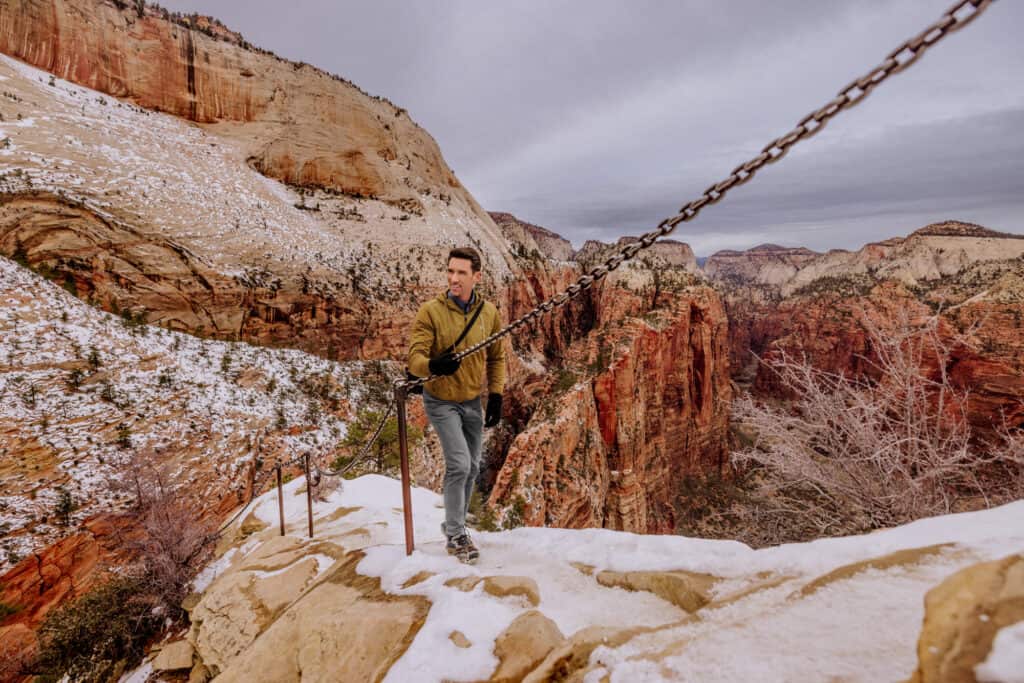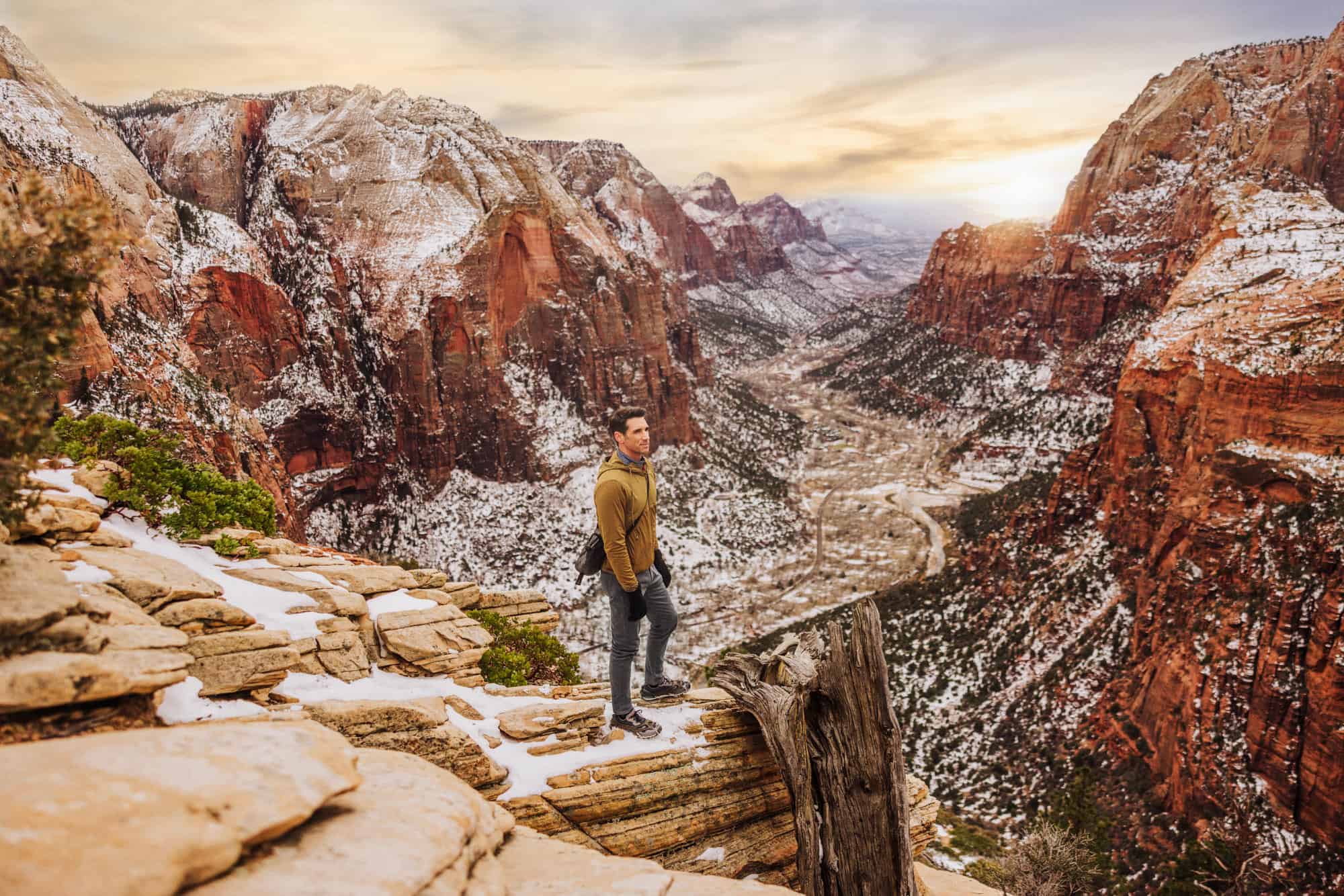Winter in Zion National Park: The Weather, Hikes & More

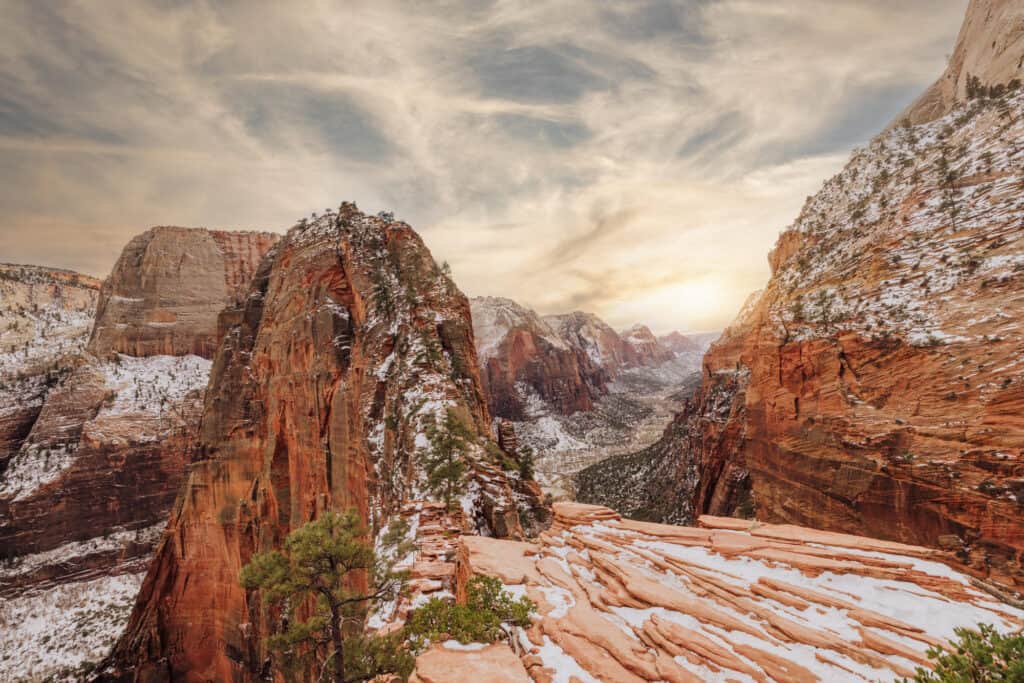
While some services may be limited and the weather may hamper your plans at times, winter in Zion National Park offers visitors a much more tranquil experience!
The snow-capped red rocks will create beautiful scenery, most of which is still accessible to explore in the winter months.
For me, the big lure for a winter visit to Zion is: there’s far less traffic, and it’s much easier to get a permit to hike the famous Angel’s Landing Trail.
Key Info on Winter in Zion:
- Entry to the park is $35 per car.
- Up-to-date information can be found on radio channel 1610AM.
- The shuttle system does not run in winter.
- Parking lots still fill up in winter.
- Click here for current conditions in the park.
- Cell signal is limited, so download maps before you enter the park.
- Temperatures can be mild, and snowfall is usually limited and sporadic at lower elevations.
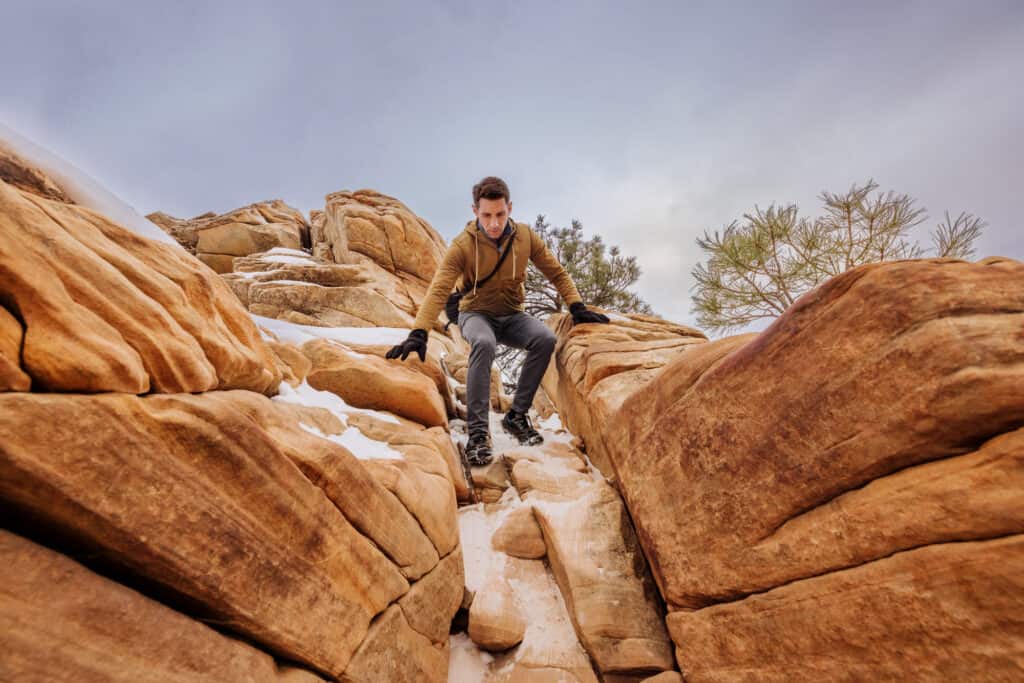
Winter is a Good Time to Visit Zion National Park
Winter is the off-season for Zion, so you’ll have far fewer visitors to compete with! And that’s just the start of why I think winter in Zion is so enjoyable.
- Mild Temperatures: Don’t get me wrong: winter in Zion can get cold! Still, winter temperatures in Zion are generally milder compared to other parts of the country. Daytime temperatures are often in the 50s, even in December and January, which is great for hiking the trails.
- Permit Possibilities: The daily permit lottery for the Angel’s Landing hike still runs in winter. With fewer people applying, your chances of winning increase dramatically!
- Photography: Zion isn’t as green in the winter, but the snow-covered landscapes create beautiful landscapes.
- Clearer Views: Winter air tends to be clearer, offering better visibility of the stunning landscapes. This can enhance the overall visual experience, allowing you to see distant formations with greater clarity.
- Stargazing Opportunities: With fewer artificial lights and reduced atmospheric haze, winter nights in Zion can offer excellent stargazing opportunities. The park is known for its dark skies, which attract amateur astronomers year-round.
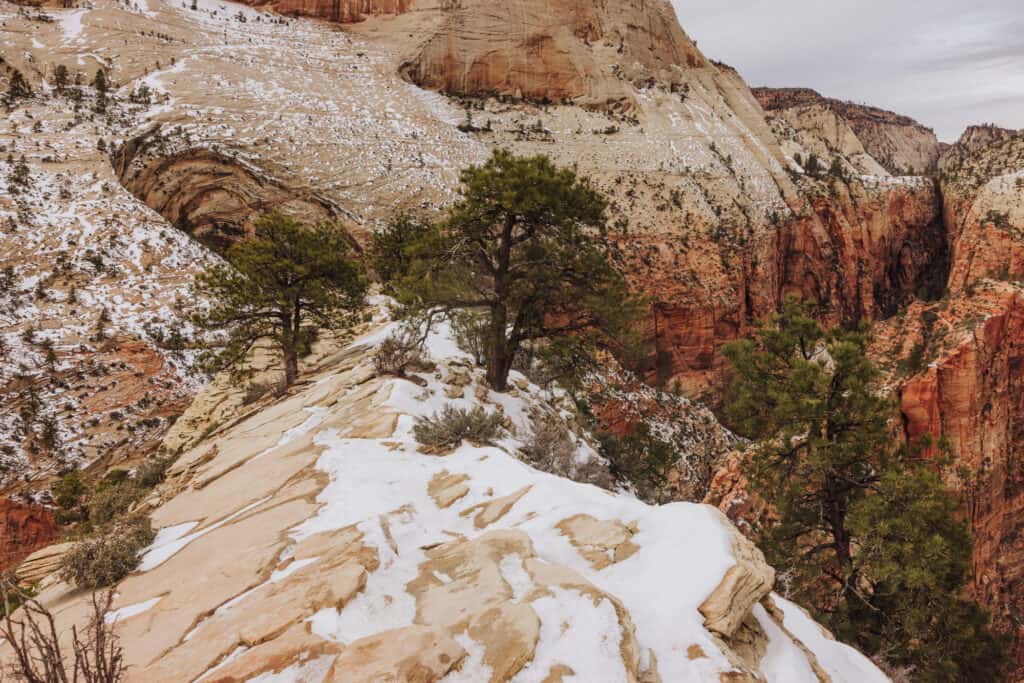
Where to Stay Near Zion in Winter
There are many lodges, hotels, and rentals to stay in, just outside the park boundaries in Springdale, Utah. You can plug your dates into this interactive map to check the availability and rates for your trip:
Winter Camping in Zion
Zion National Park has three campgrounds. Most of them are completely booked from March (when spring break trips begin) through Thanksgiving! So, if you’re a camper, try to book a reservation early.
Only Watchman Campground is open in winter at the moment. You can make reservations six months ahead of your visit to Zion.
South Campground is undergoing a rehab project, so parts are closed currently. And Lava Point is closed in the winter.
Reservations at Watchman Campground (Call 877-444-6777 or visit www.recreation.gov) are recommended if you would like to guarantee a camping spot.
Fly to St. George, Utah
The growing city of St. George is home to a small, but efficient airport.
The drive from St. George to Springdale (the gateway to Zion) is just about 40 miles. Depending on traffic conditions, it’s about an hour’s drive to the park entrance.
Delta, United, and American Airlines all fly to St. George.
The lot is full of rental options from all of the big rental companies. If you’re going to Zion in winter, consider an all-wheel drive vehicle, if not a 4×4.
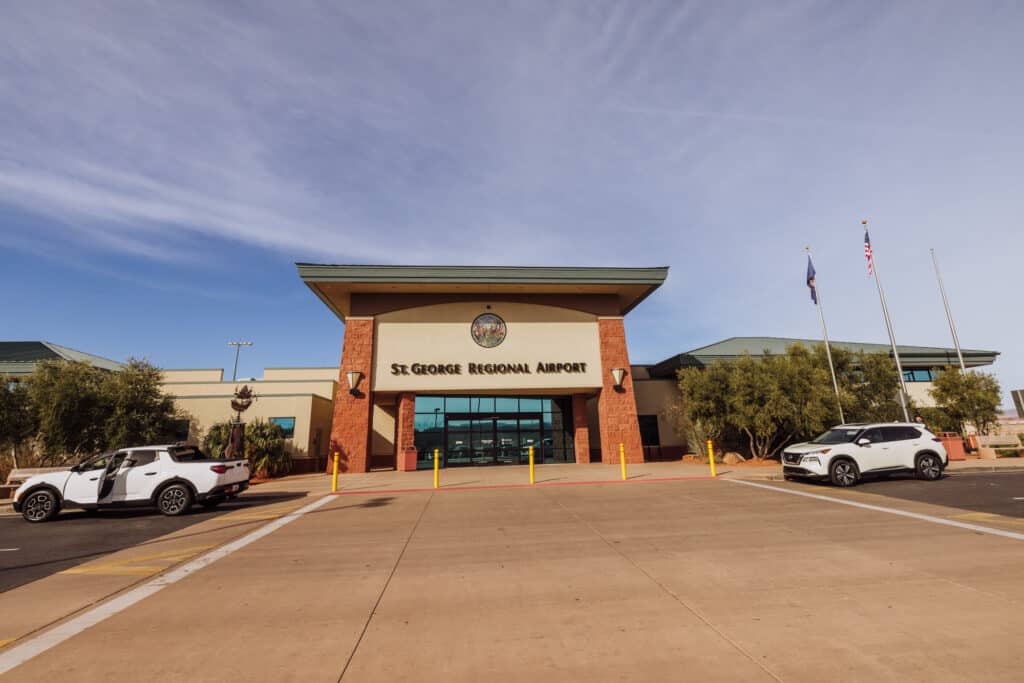
Winter Weather in Zion National Park
You can plan an amazing winter trip to Zion, and have it spoiled by a snowstorm! The good news is: they know how to deal with the snow, and it usually doesn’t accumulate too much. So even if you’re cooped up waiting for roads to reopen, it’ll probably just affect one day of your trip.
Winter Weather and Snow in Zion
The elevation at the gates of Zion National Park in Springdale, Utah, is around 3,900 feet (1,189 meters).
The Zion Canyon floor, where popular trails like the Narrows and Angels Landing are located, typically experiences milder winter conditions.
Snowfall is likely through the winter, but it really only accumulates much more at higher elevations.
The record snowfall in Zion from a storm is just over one foot.
While snow is a possibility, I wouldn’t let it deter me from a trip to Zion in winter.
Icy Trails
On trails at higher elevations, like the upper portion of Angel’s Landing, snow tends to stick around and turn icy. Bring spikes (or crampons) to put on your shoes if you plan to hike.
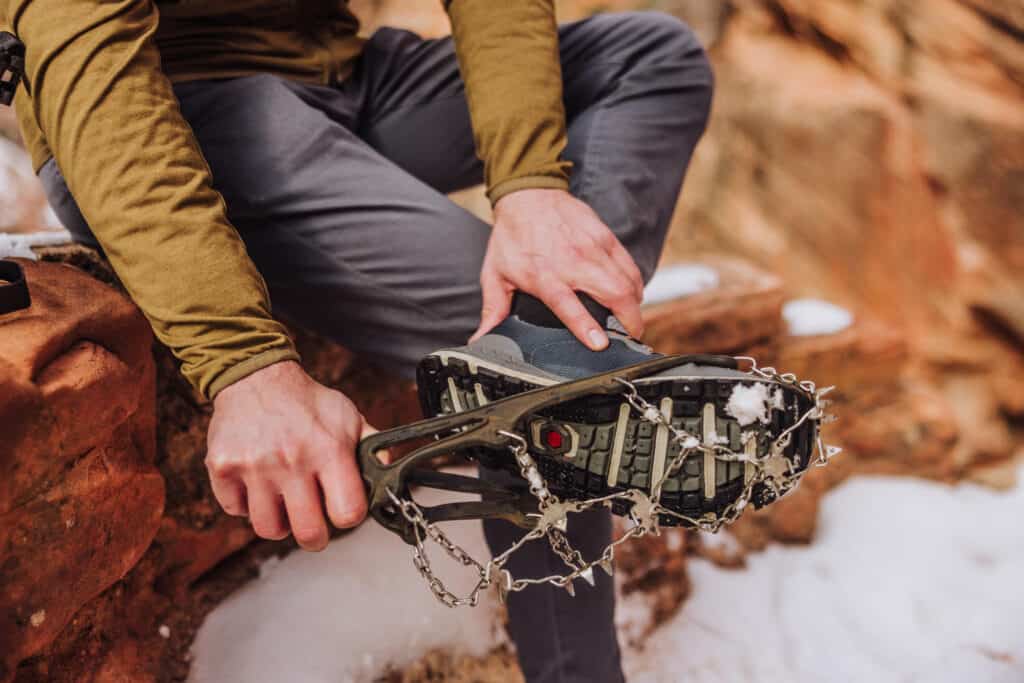
Winter Hikes in Zion
Winter in Zion National Park can be a beautiful time to hike the trails. Some at higher elevations will be affected by snowy, icy conditions.
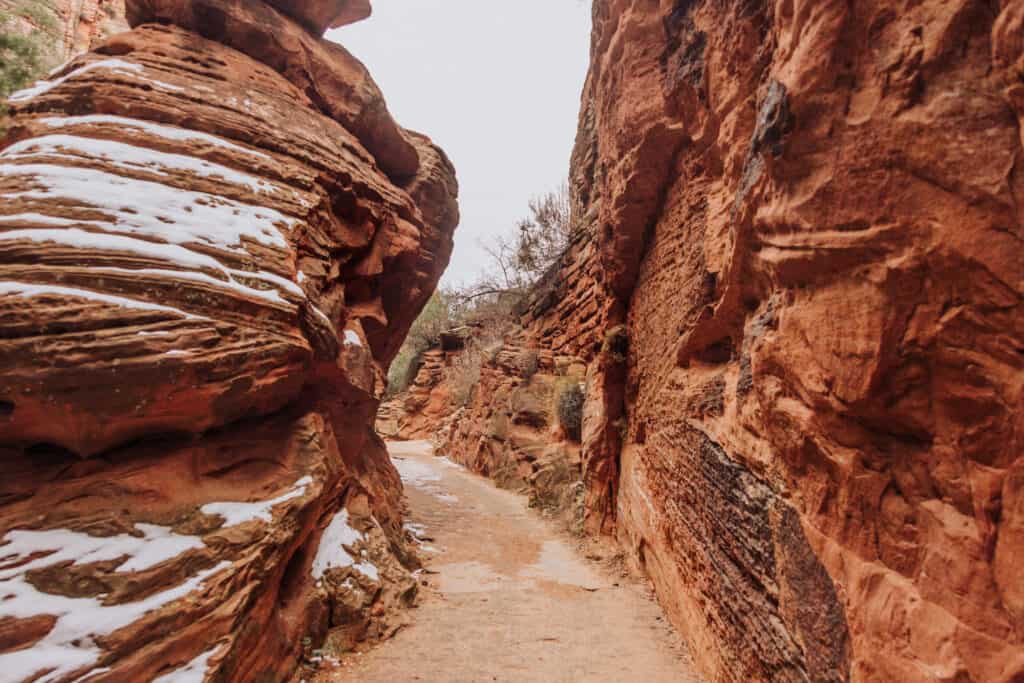
There are numerous options through the winter months. Here are five trails that are usually accessible and enjoyable in winter:
Scout Lookout
- You’ll hike a partly-paved trail about 2 miles each way. It’s steep in spots, and you should bring crampons or spikes for your shoes in case it’s icy. Angel’s Landing is beyond the lookout. Beautiful views of the canyon!
Pa’rus Trail
- The Pa’rus Trail is a 3-mile paved trail, which is mostly flat and follows the Virgin River through the main canyon. It’s a scenic and accessible option, suitable for winter hiking, jogging, dog walking, and even pushing a stroller.
Watchman Trail
- The Watchman Trail provides panoramic views of the main canyon. It’s steep in spots, and can be muddy and/or icy, but the views are beautiful. it can be steep in sections, it’s a relatively short hike, and is often accessible in winter, offering a different perspective of Zion.
Canyon Overlook Trail:
- The Canyon Overlook Trail offers stunning views of Zion Canyon and is accessible year-round. It’s shorter (about a mile) and easier, but still a great winter option.
The Grotto Trail to the West Rim:
- If parking is full at the Grotto lot, you can park at the lodge down the road. This trail is considered longer (9 miles) and more challenging, but leads to sweeping views of the canyon.
Angel’s Landing in Winter
Angel’s Landing is probably the most famous hike at Zion National Park.
- Distance (round trip): 5.4 miles
- Elevation gain: 1500 feet
- Time: 4-5 hours
- Level of difficulty: Strenuous
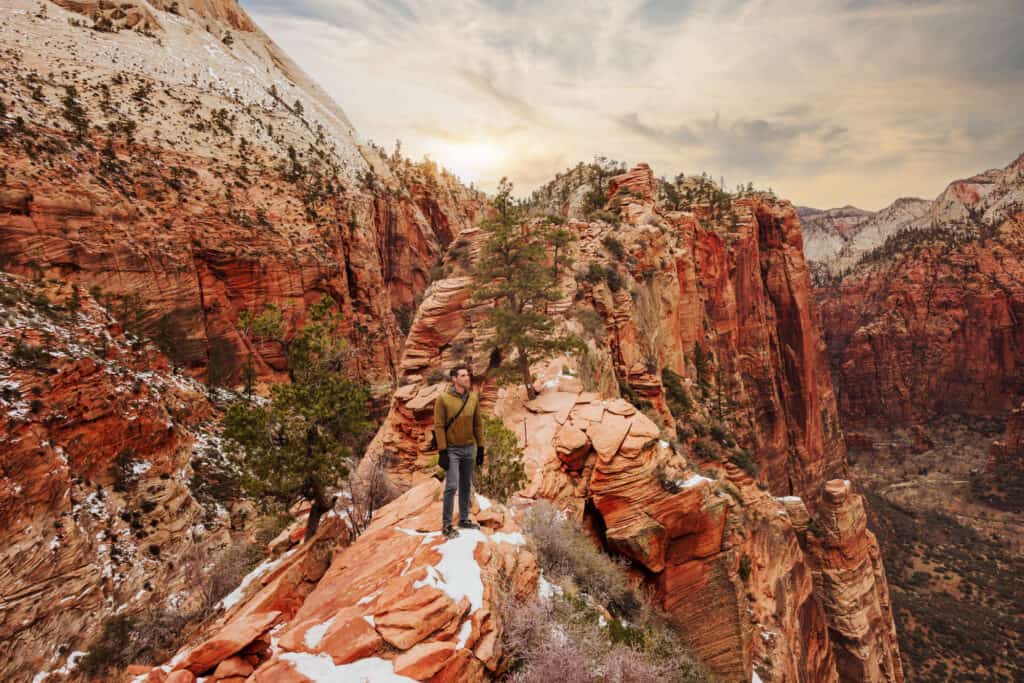
Permits for Angel’s Landing
Everyone who hikes Angels Landing needs a permit. The permit system was put into place after overcrowding in 2019 and 2021 made the hike unenjoyable. Major portions of the trail are single-file, so hikers were forced to wait in lines as others came up or down.
The NPS posted this photo at the trailhead to show the reasoning behind the permit system:
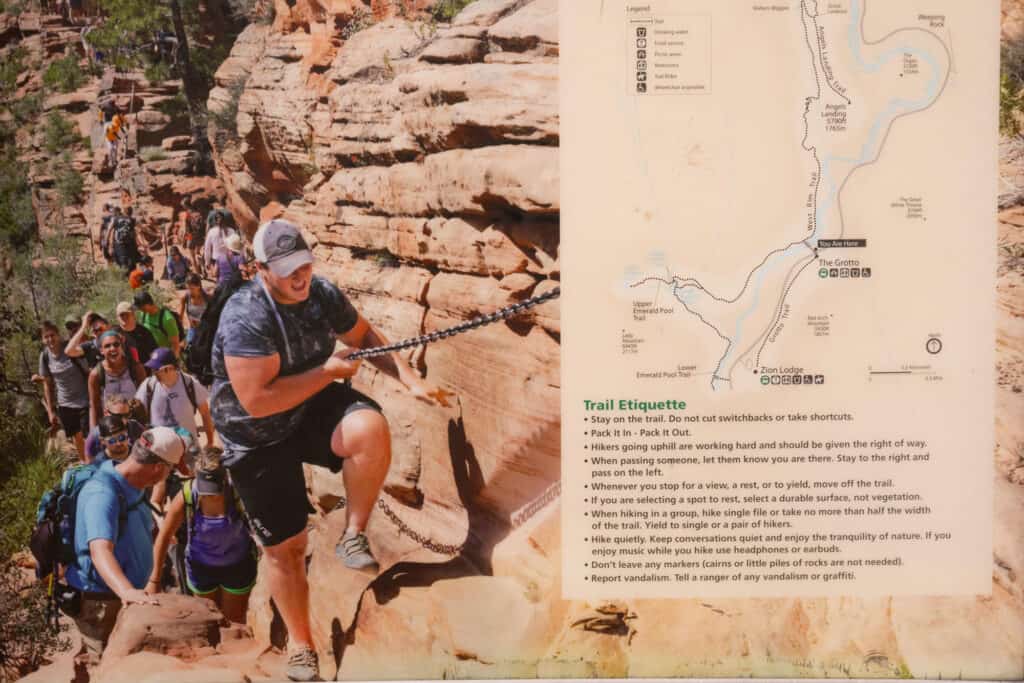
<div>You can apply for a permit in one of two ways: in a lottery system months before your visit, or in the daily lottery one day before your visit.
The cost is a non-refundable $6 fee. Your chances of securing a permit to hike Angel’s Landing increase in the winter, as fewer people enter the pool of applicants.
The daily lottery opens on recreation.gov every day at midnight, and closes at 3:00pm. Each permit covers up to six people. Winners are emailed around 4:00pm.
You’re very likely to encounter a ranger at the trailhead or along the trail checking permits.
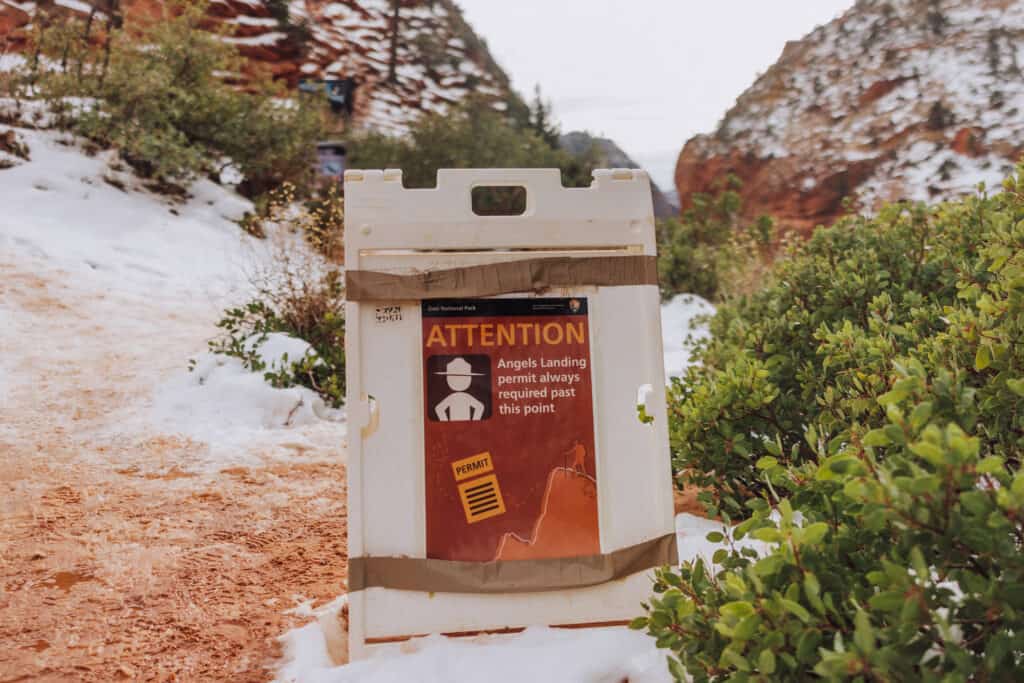
The Grotto Trailhead
The Grotto is the best parking lot for Angel’s. Landing. The trail starts right across the street.
It’s a small lot, with very limited parking. If it’s full, you’ll have to park down the road at the Zion Lodge and hike the extra half-mile to the trailhead.
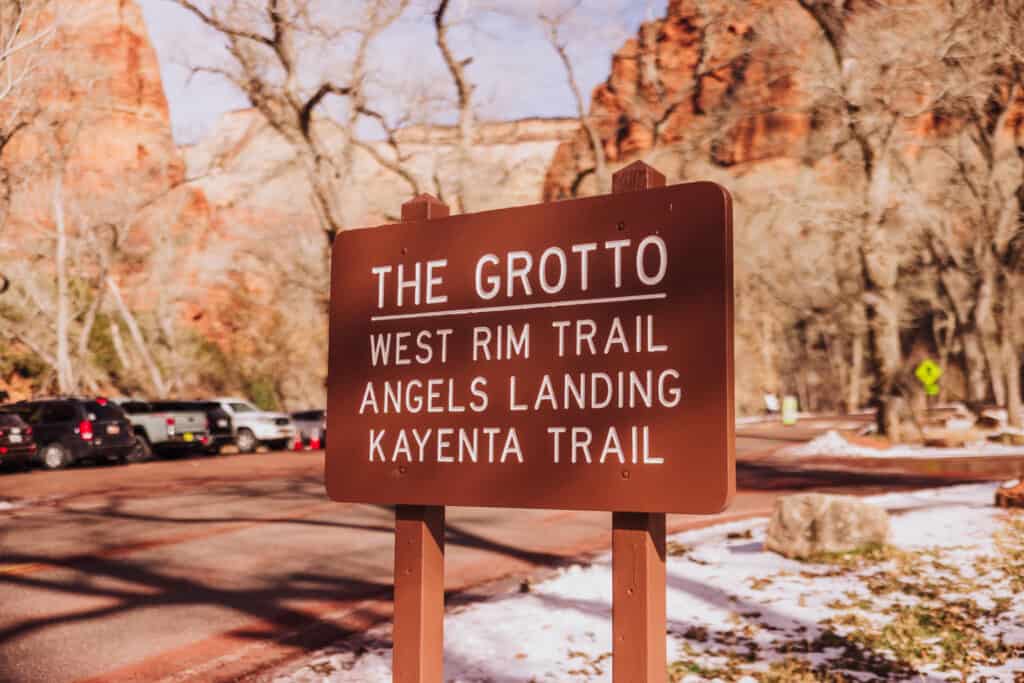
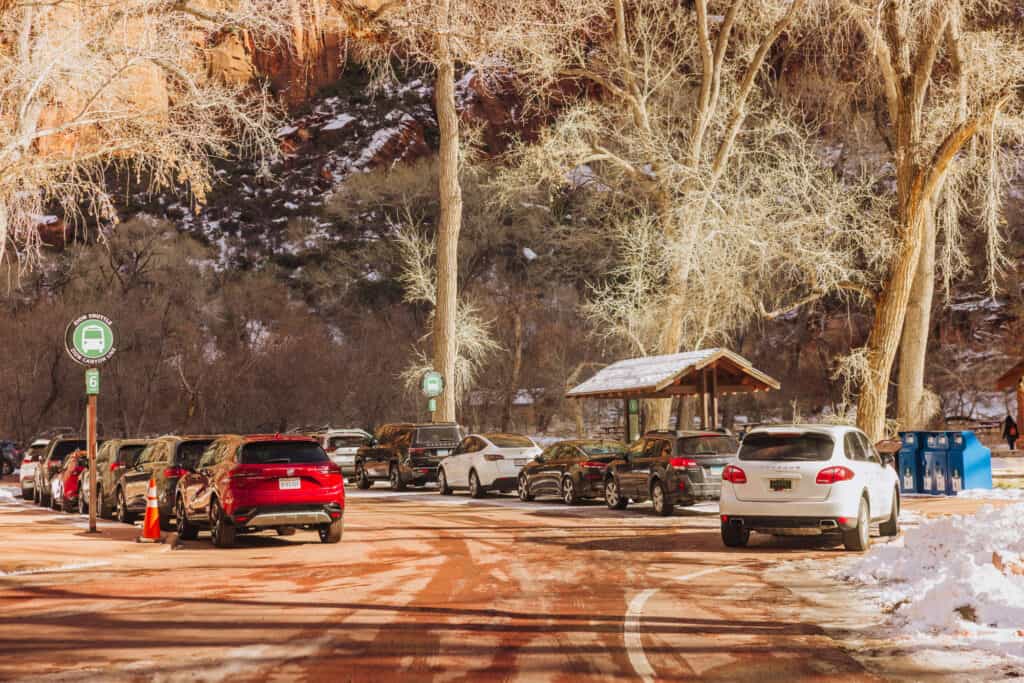
The Angel’s Landing Trail
Hiking to Angel’s Landing will take you along a popular route that coincides with other hikes.
You’ll be hiking with people heading to Scout Lookout, and the West Rim.
I was surprised to see how much of the trail is paved and smooth.
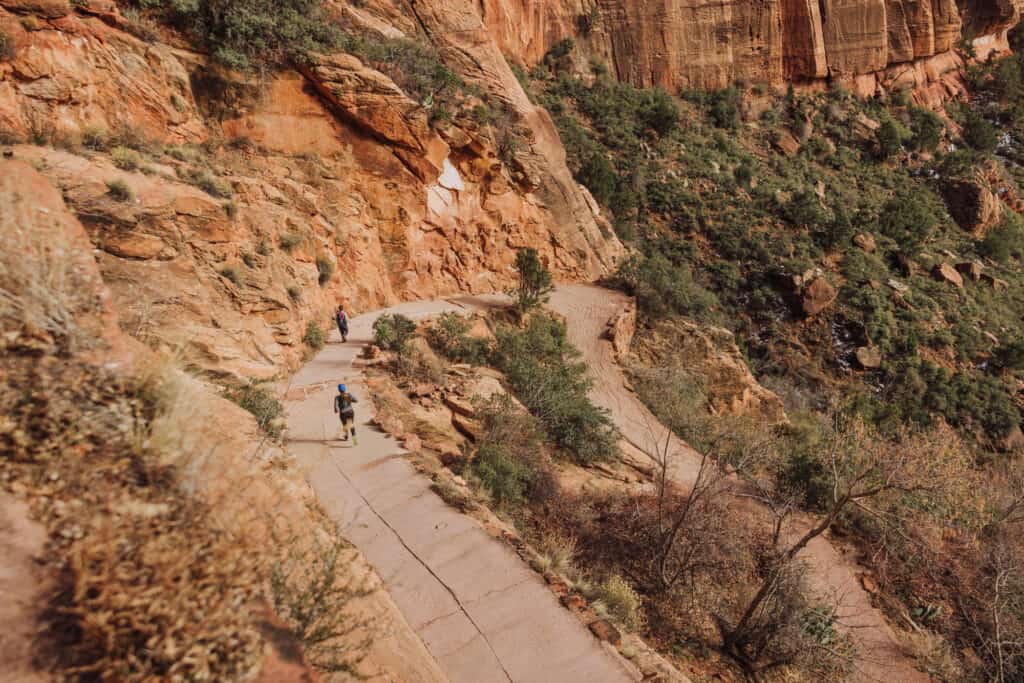
It’s steep in spots, and the snowfall turns icy as you get to the higher elevation.
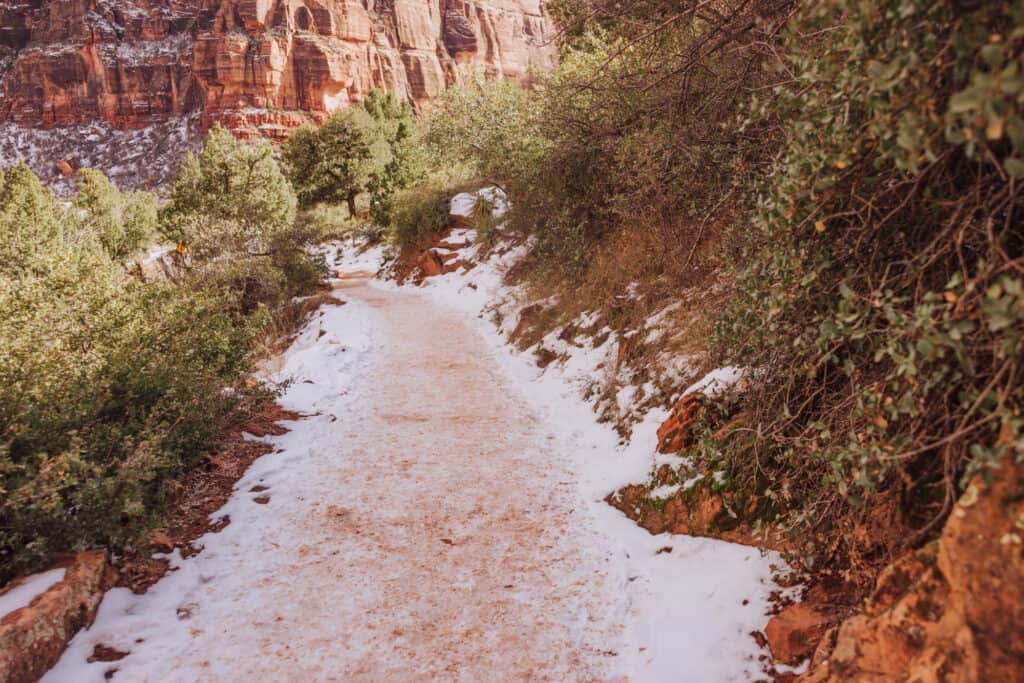
Walter’s Wiggles
Walter’s Wiggles consists of 21 tight switchbacks that climb up a steep section of the trail.
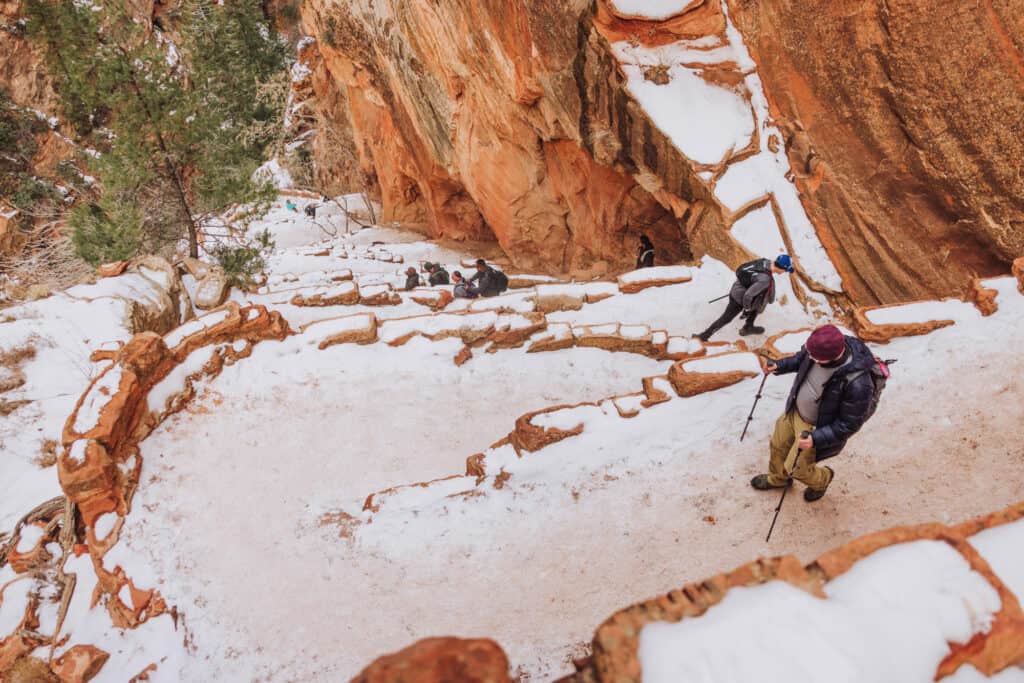
The switchbacks are named after Walter Ruesch, the first superintendent of Zion National Park, who was instrumental in the construction of the trail in the 1920s.
The switchbacks are designed to help hikers manage the steep terrain.
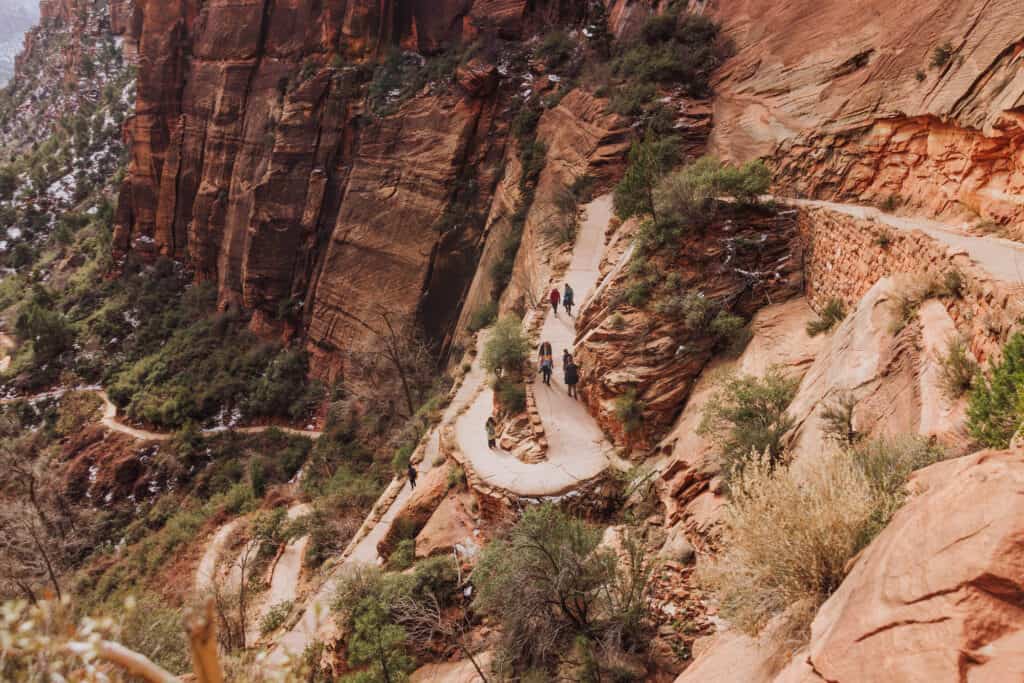
Beyond Walter’s Wiggles, the trail continues to the final section leading to the summit of Angels Landing.
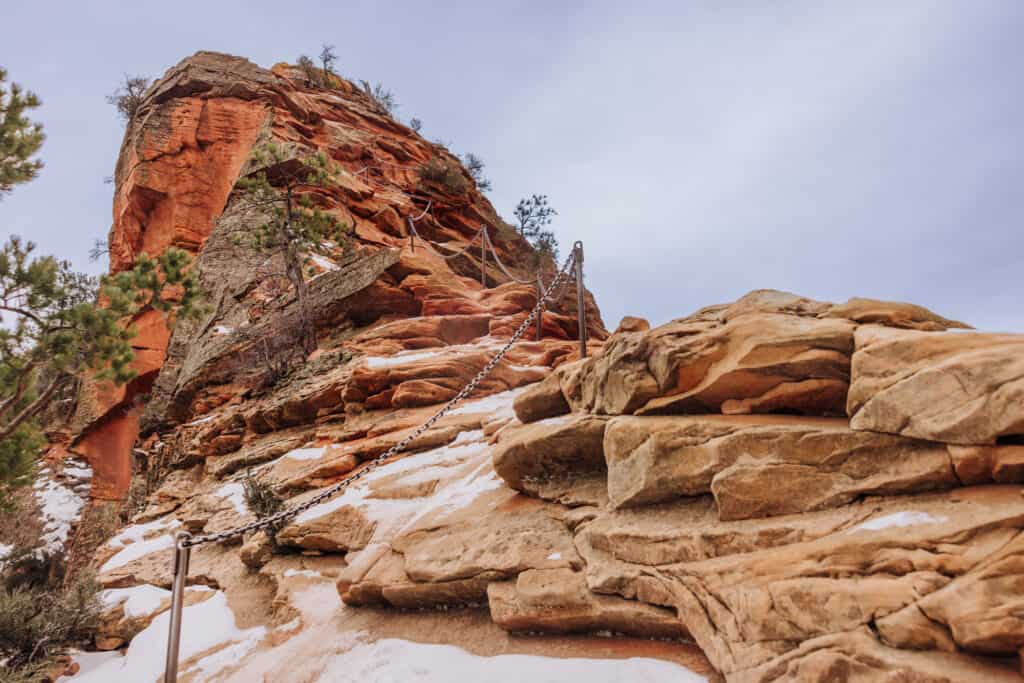
Angel’s Landing Chains
The chain-assisted section is located near the final stretch of the Angel’s Landing Trail, leading to the summit. This part of the trail involves navigating a narrow ridge with steep drop-offs on both sides.
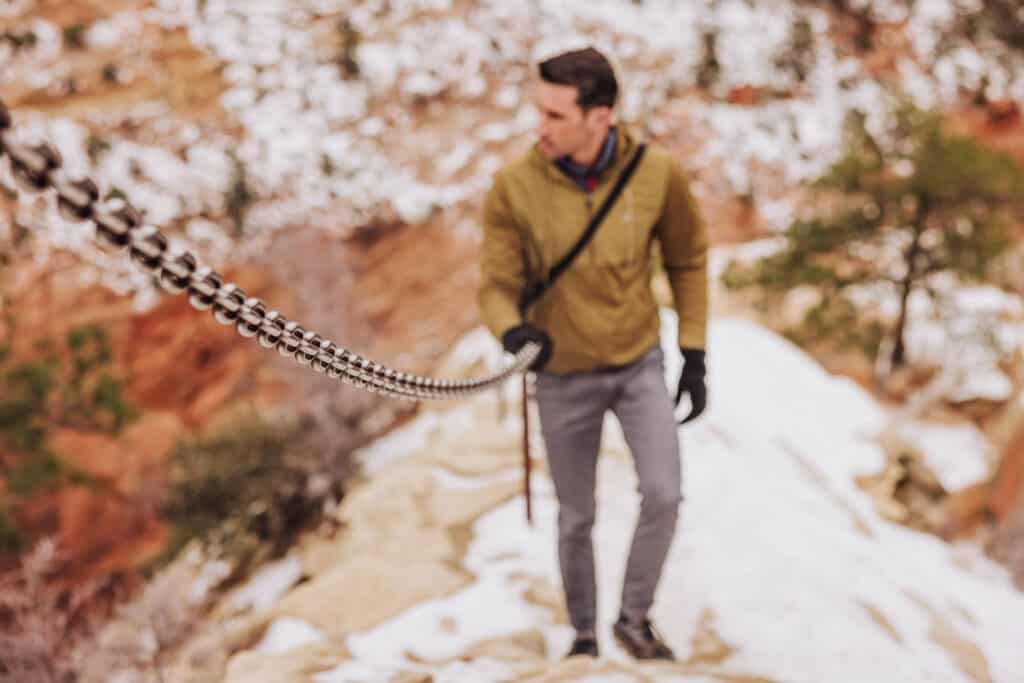
Beyond Scout Lookout, hikers will rely on the chains to climb up the ridge. They’re anchored into the rock and provide a reliable handhold.
The chains are not only useful for ascending to the summit but also for descending safely!
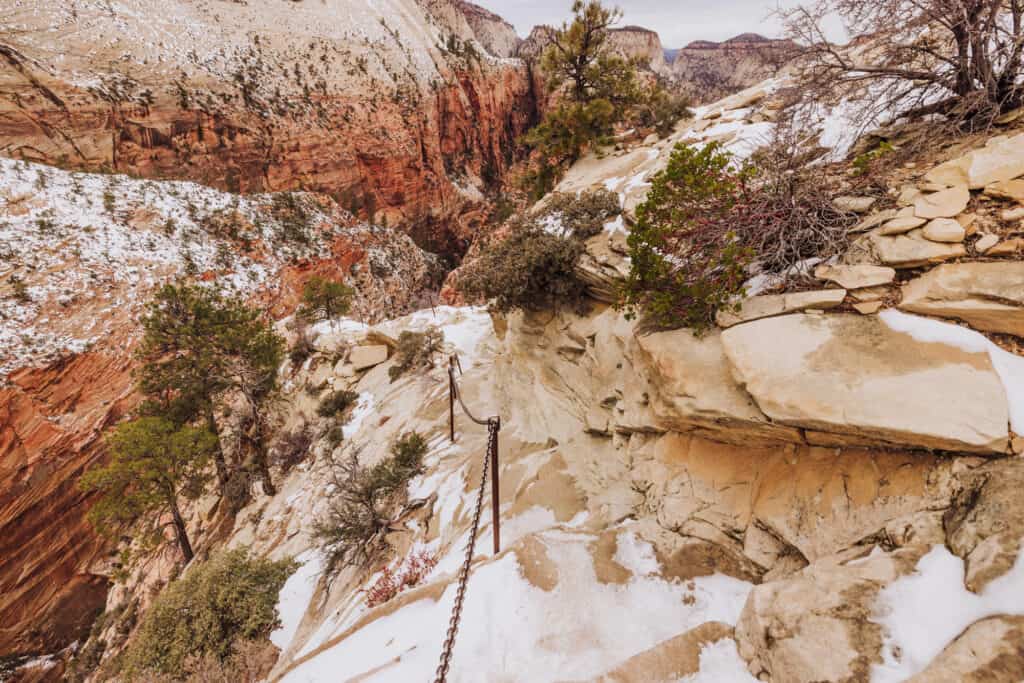
The View from Angel’s Landing
There’s an amazing payoff for this hike: panoramic views of the canyon below. In winter, you’re likely to see snow-capped red rocks surrounding you.
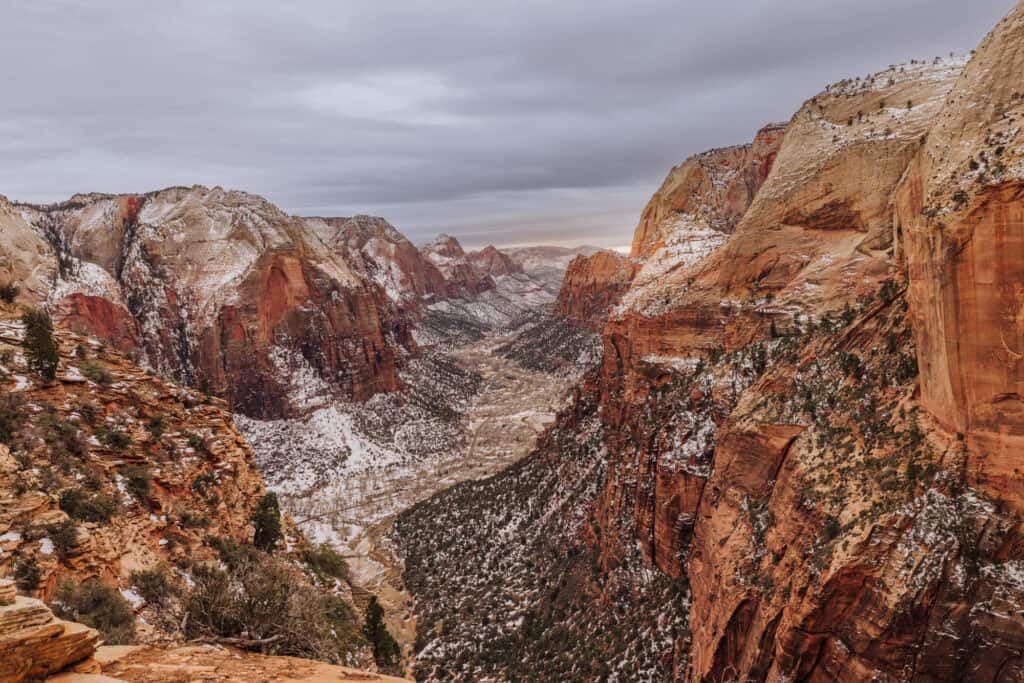
A lot of people bring snacks up to relax for a while before hiking down.
In winter, you’re likely to have some time on the summit with just a few other hikers, or even by yourself!
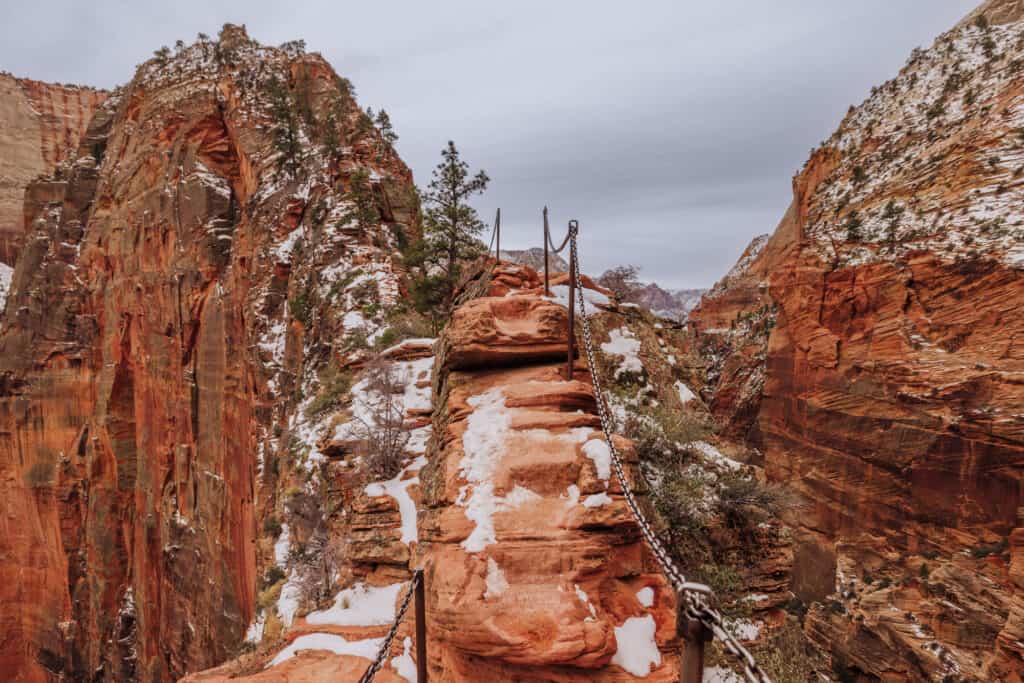
The Narrows in Winter
The Narrows is the other most famous hiking experience in Zion National Park. It refers to a section of the Zion Canyon where the North Fork of the Virgin River has carved a deep, narrow slot canyon between towering sandstone walls.
Much of the hike itself will be in the river, so hiking the Narrows will be cold! To hike safely, you’ll likely need a dry suit.
The Narrows closes each spring when snowmelt creates higher water levels. The water has never risen to the point in winter that forced a closure (at least in recent history).
The Narrows Closures
- 2012: Closed April 17 – April 27
- 2013: Closed April 30 – May 1
- 2014: Only brief closure
- 2015: Only brief closure
- 2016: Closed April 3 – May 21
- 2017: Closed March 11 – May 20
- 2018: Only brief closure
- 2019: Closed April 6 – June 21
- 2020: Closed April 9 – May 17
- 2021: Only brief closure
- 2022: Only brief closure
- 2023: Closed April 8 – June 18
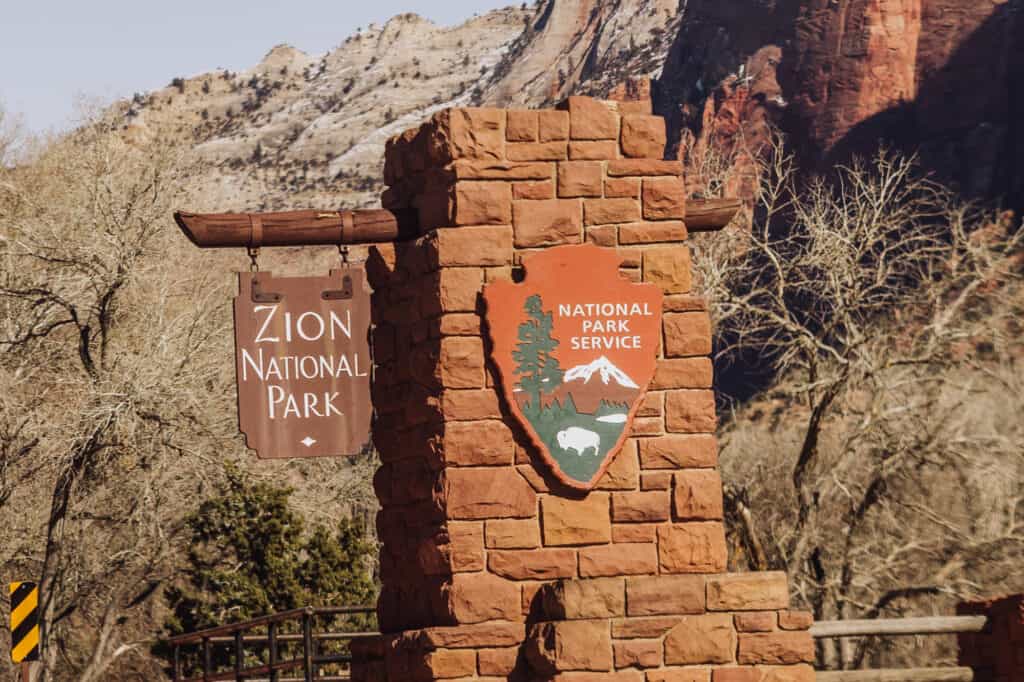
Zion’s Canyon Scenic Drive in Winter
Winter is a great time to take the 6-mile Canyon Scenic Drive! From January through March, all personal vehicles are allowed on the road through the park. From spring through fall, access is by shuttle bus only.
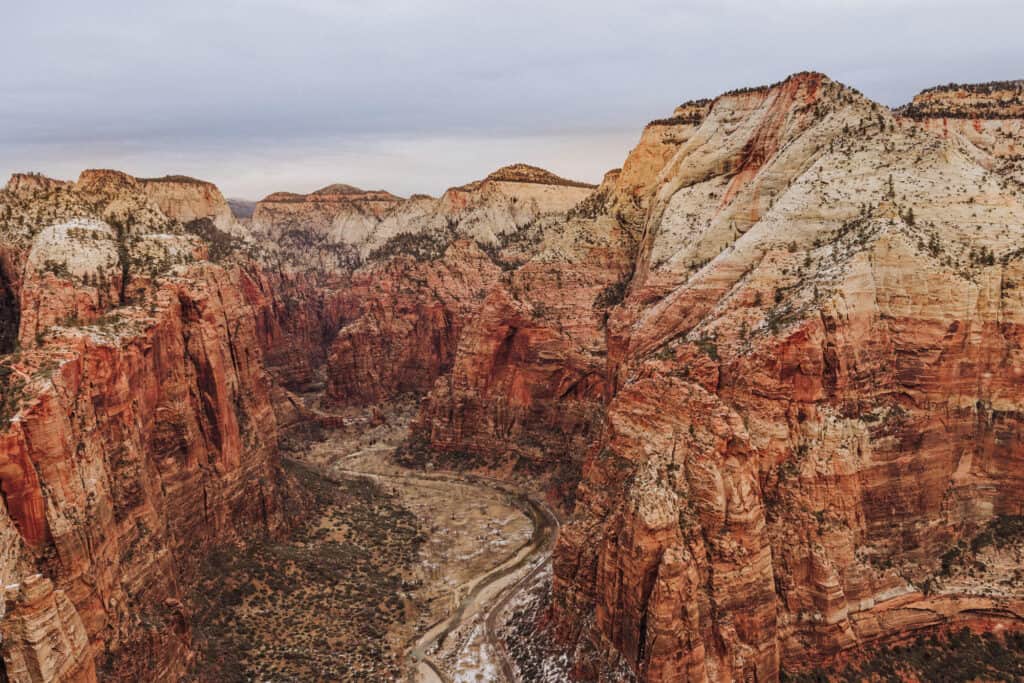
There’s No Zion Shuttle Bus in Winter
Zion National Park operates a shuttle system in the main canyon to reduce traffic congestion and minimize the environmental impact of private vehicles.
The shuttle buses that run from Springdale through popular parts of Zion National Park usually shut down just after Thanksgiving each year.
They run for about 10 days between Christmas and New Year’s, before shutting down again until larger crowds return in the spring.
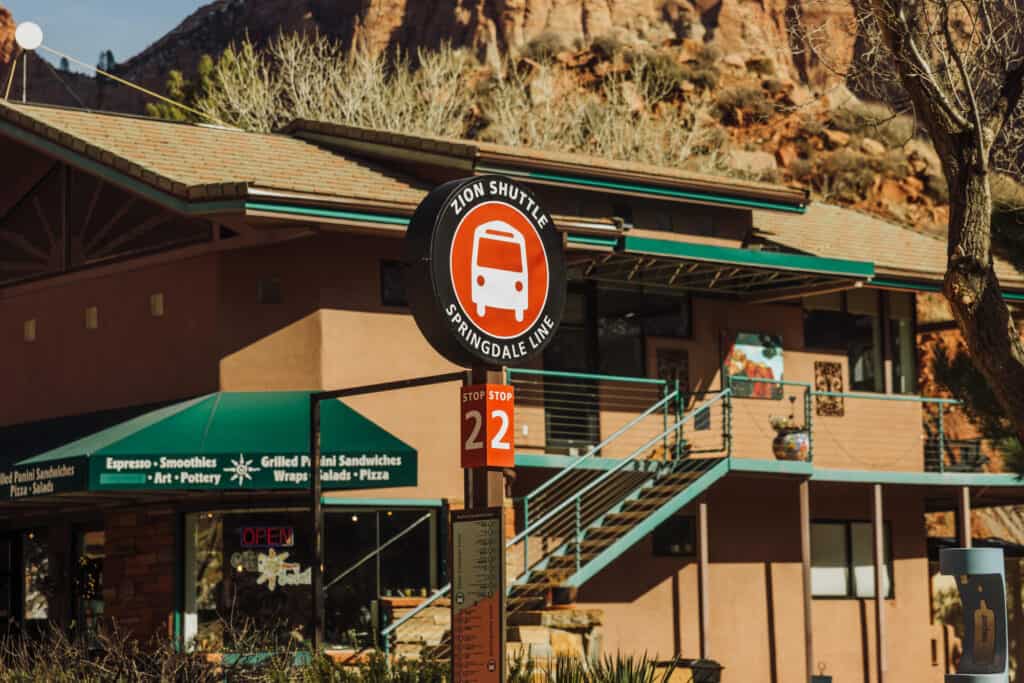
Traffic in Zion in the Winter
Even with fewer visitors in the winter months, Zion will be pretty crowded. You may end up in a line of cars at the entrance of the park, or at some of the trailheads as rangers try to ease congestion on the Canyon Scenic Drive.
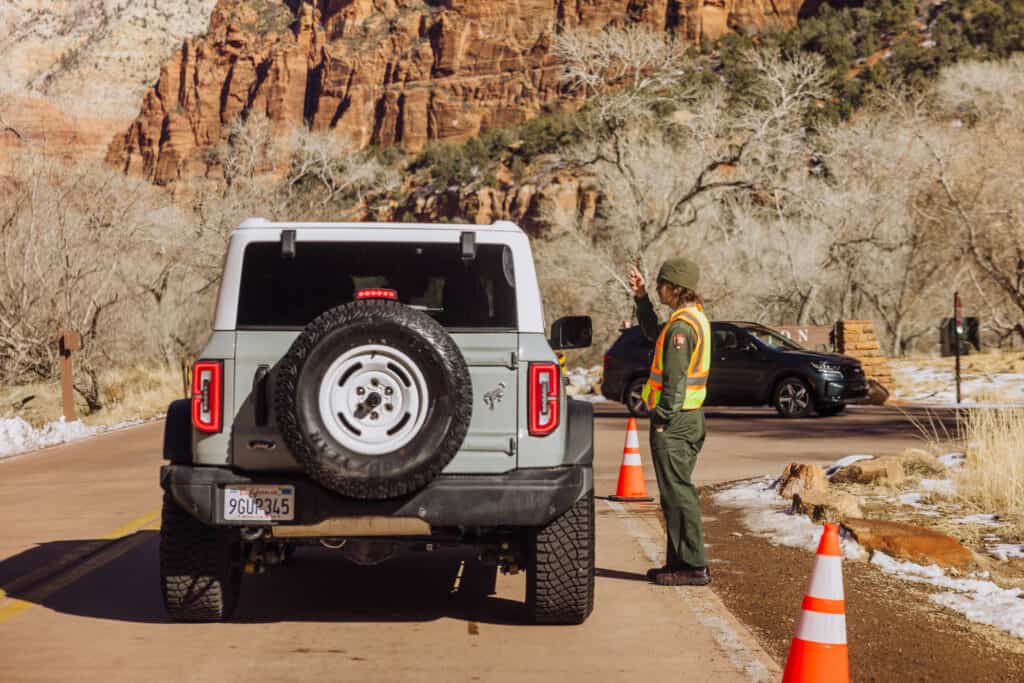
When parking lots in the canyon fill up, the NPS temporarily closes the road to additional drivers. The best time to take the drive is early in the morning or later in the day.
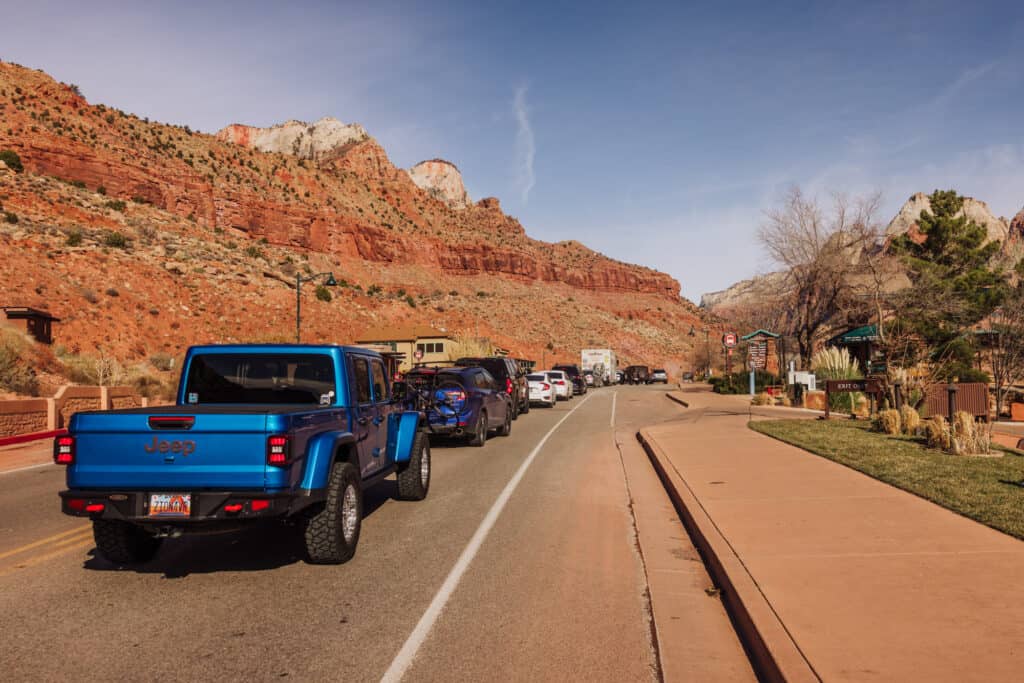
Crowds at Zion in Winter
The National Park Service updates visitor numbers, and they show the gradual growth in popularity of Zion National Park over the decades. Around 2015, yearly visitor numbers began to grow faster:
- 1980: 1.23 million visitors
- 1985: 1.5 million visitors
- 1990: 2.1 million visitors
- 1995: 2.4 million visitors
- 2000: 2.4 million visitors
- 2005: 2.59 million visitors
- 2010: 2.67 million visitors
- 2015: 3.65 million visitors
- 2019: 4.49 million visitors
- 2020: 3.59 million visitors (pandemic)
- 2021: 5.04 million (peak)
- 2022: 4.7 million visitors
- 2023: 4.62 million visitors
Zion: Winter vs. Summer Crowds
These are the monthly totals for 2023. They show how visitor numbers dip in the winter months in Zion:
- January: 114,000
- February: 130,500
- March: 336,200
- April: 450,800
- May: 514,300
- June: 564,000
- July: 561,000
- August: 458,500
- September: 491,800
- October: 504,600
- November: 285,000
- December: 212,400
Key Advice on a Winter Trip to Zion
Weather is the big unknown in the winter, but in general visitors to Zion should keep these things in mind:
- Limited Services: During the winter months, some facilities and services will be limited or closed in the park. Visitor centers, shuttle services, and other amenities may have reduced hours.
- Limited Cell Signal: You’ll completely lose cell service in much of Zion. Make sure to download hiking trail maps on AllTrails or the NPS app before heading in.
- Pack Layers: Wear warm layers to stay comfortable in fluctuating temperatures. A waterproof jacket and sturdy, insulated footwear are essential, especially if you plan to hike trails, which will likely be snowy or ice-covered in spots.
- There’s Less Daylight: The sun doesn’t rise until the 7 o’clock hour, and it sets around 5:00pm in the winter, so the days will be short. It means timing your hikes and activities to get back to the trailheads before dark.
- Trails & Roads Could Close: If a storm moves through, roads and trails may be closed or restricted. Check 1610AM (on the radio) for updates if you’re in the area.
- Vehicle Preparation: If you’re driving, be prepared for winter road conditions. If you’re renting, make sure the wipers work well before leaving the lot, and make sure there’s an ice scraper for you to use.
What to Pack for Winter in Zion National Park
While daytime temperatures might be in the 50s, it’s a good idea to be prepared for all kinds of weather conditions for a winter trip to Zion.
Here’s my packing list for winter:
Layered Clothing:
- Insulating layers (thermal shirts, fleece jackets) which are easy to shed if you get hot.
- Waterproof and windproof outer layer (jacket and pants) to protect against rain or snow.
Warm Accessories:
- Hat and gloves to retain body heat.
- Scarf for your neck if it’s windy.
- Hand and foot warmers.
Sturdy Footwear:
- Waterproof and insulated boots with good traction for hiking in snow or wet conditions.
- Extra socks to change into dry pairs.
- Spikes or crampons for your shoes. These are a must if you’re hiking!
Hiking Gear:
- Daypack or backpack.
- Trekking poles for stability, especially on icy or uneven terrain. These are personal preferences.
Navigation:
- Map of the park and trails.
- NPS app with downloaded trail maps
- AllTrails app with downloaded trail maps.
Sun Protection:
- Sunglasses with UV protection.
- Sunscreen for your face.
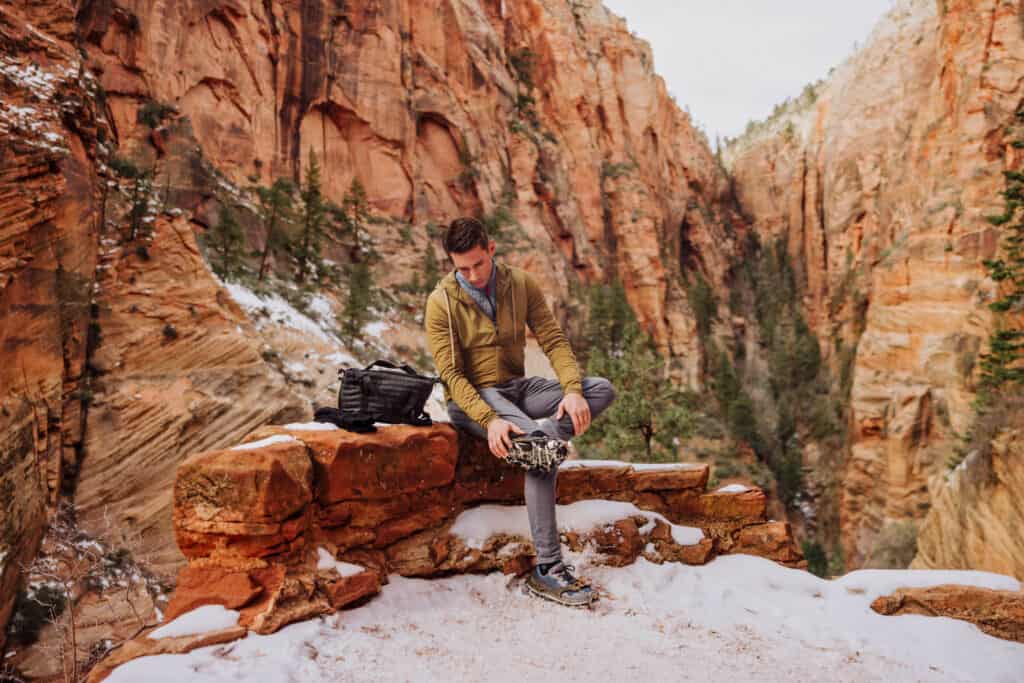
Zion in December
Here are some characteristics of Zion National Park in December:
Weather in December
- Average high: 54 degrees
- Average low: 30 degrees
- Average precipitation: 1.6 inches
- Record daily snowfall: 8 inches
Hiking in December
- It’s off-season, so fewer people are on the trails
- Most trails are open, but conditions will vary
- Angel’s Landing is open, but be prepared for icy conditions higher up.
Park Services in December
- The shuttle service from Springdale closes after Thanksgiving.
- The shuttle usually reopens for Christmas week into New Year’s.
- Otherwise, you can drive personal vehicles through the canyon.
- Visitor centers are open 8:00am – 5:00pm.
Zion in January
I really enjoy Zion National Park in January! You’ll find traffic on the roads, but it’s still surprisingly mild (many days).
Weather in January
- Average high temp: 54 degrees
- Average low temp: 30 degrees
- Average precipitation: 1.8 inches
- Record daily snowfall: 12.5 inches
Hiking in January
- It’s easier to get permits for Angel’s Landing, since fewer people apply.
- Trails will be icy at higher elevations.
Park Services in January
- The shuttle closes after New Year’s.
- You can drive through the canyon in your personal car.
- The Lodge and Watchman Campground are open.
- Visitor centers are open 8:00am – 5:00pm.
Zion in February
February is also a good month to visit Zion, before spring break crowds arrive in March.
Weather in February
- Average high temp: 59 degrees
- Average low temp: 34 degrees
- Average precipitation: 2 inches
- Record daily snowfall: 8 inches
Hiking in February
- Fewer nights drop below freezing, and daytime highs rise into the upper 50s, so the ice starts to melt at higher elevations.
Park Services in February
- Zion’s shuttle service remains closed through the month, before reopening sometime in March.
- Visitor centers are open from 8:00AM to 5:00PM.
Wildlife You’ll See During Winter in Zion
You’re likely to encounter some wildlife even during winter in Zion! Mule deer, bighorn sheep, and eagles are active in the winter months.
California Condors
Zion is a sanctuary for condors, which nearly went extinct in the early 1980s. Only 22 existed worldwide. They were captured for a breeding program.
The birds have been reintroduced into Zion and other parts of the West. Around 70 live in the region, and you’re likely to see them soaring over the Angel’s Landing trail.

FAQs on Winter in Zion
Let’s go over a few frequently-asked-questions about a winter trip to Zion National Park. Many of these have already been answered above.
Can you do The Narrows in winter?
Yes, but it’ll be cold. They advise hiking the Narrows in a drysuit, since you’ll be in the river for much of the hiker. The trail usually closes at some point in the spring, if snowmelt causes rising water levels.
Are Zion’s campgrounds open in winter?
Only the Watchman Campground near the Springdale entrance is open all winter.
Is Zion less crowded in winter?
Yes, while you’ll still find traffic on the road through the canyon and parking lots full, it’s easier to get a permit for Angel’s Landing. In general, you’ll encounter far fewer people on the park’s trails.
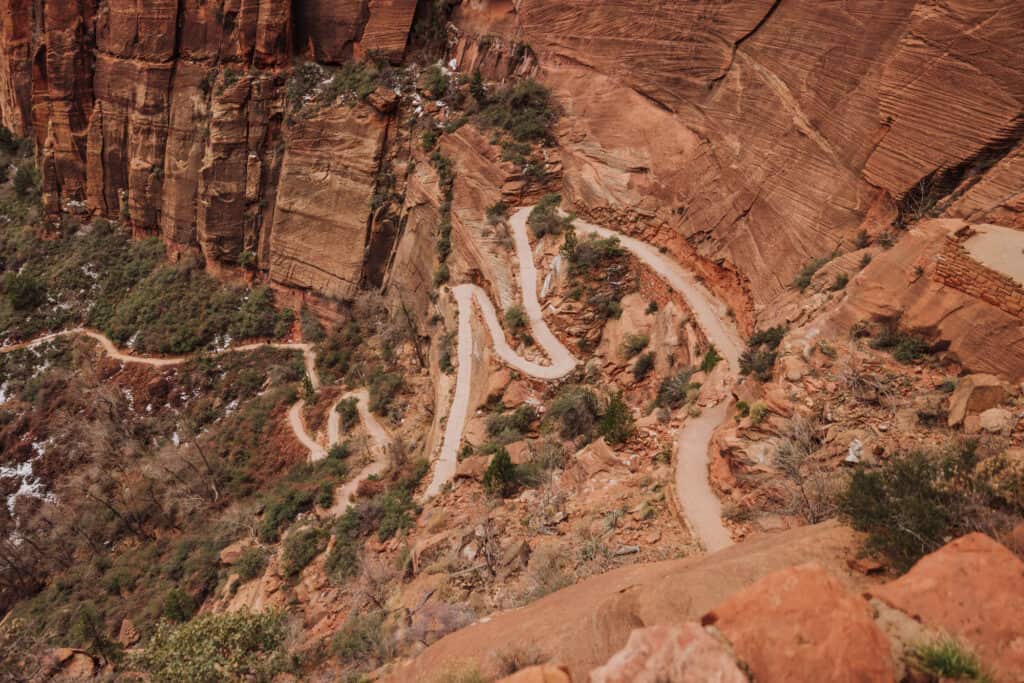
Can I drive my own car through Zion National Park?
Yes, the shuttle service closes after Thanksgiving, and doesn’t resume until March. It may operate around Christmas and New Year’s, but otherwise you’re allowed to drive your personal vehicle through Zion in the winter months.
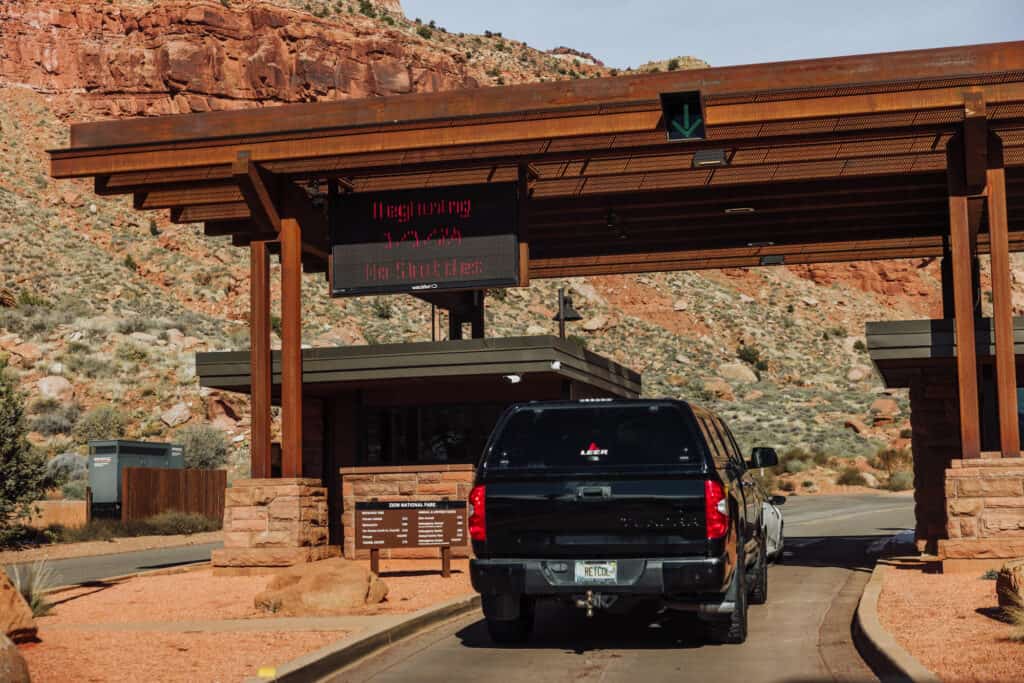
Wrap: Winter in Zion National Park
Zion National Park is a great place to visit in the winter months. It’s cooler, of course, but still mild enough (usually) to enjoy the hiking trails.
The iconic red rock formations, like those along the Angel’s Landing trail, create breathtaking views. It’s made even more enjoyable because far fewer people will be around!
